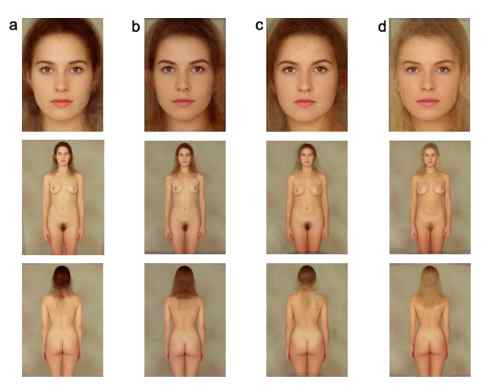Female faces
and bodies: n-dimensional feature space and attractiveness
Grammer,
K., Fink, B., Juette, A., Ronzal, G. & Thornhill, R.
in
: (2001). Female faces and bodies: n-dimensional feature space and attractiveness.
In: G. Rhodes & L. Zebrobwitz (Eds.). Advances in Visual Cognition. Volume
I: Facial Attractiveness. Ablex Publishing.

Many
studies show that female attractiveness plays an important role in human
mate selection. Research in the past has focused on the influence of single
features, e.g., eye size or breast size, in attractiveness judgements.
In recent years, bilateral symmetry and averageness or prototypic appearance
have been discussed as possible general principles of attractiveness.
The puzzle remaining is which features actually contribute to the perception
of attractiveness and how are these integrated to result in attractiveness
attribution. 
In
this paper we propose that attractiveness perception and judgment takes
place in a multidimensional feature space. If attractiveness signals mate
quality honestly, the single features making up the multiple dimension
should actually correlate positively and thereby compose a single ornament
of mate value. In a rating study, three sets of males (each n = 10) rated
three views (face alone, nude back, and nude front with face covered)
of digital images of women (n = 92) in Austria as well as in the USA.
Symmetry, averageness, skin color, hair color, stimulus complexity and
surface texture were assessed with digital image analysis. Thirty-six
features on the digital images were measured by hand at anatomically defined
points. A principal component analysis reveals that the n-dimensional
feature space can be reduced to four main dimensions. Computer simulations
of the possible underlying cognitive decision making imply that a fast
and frugal algorithm, which uses the rule “simply avoid the worst,” best
explains attractiveness ratings. Thus, beauty could be a negative concept,
which finds its expression in the avoidance of ugliness.

Figures
1 a-c. This figure shows the landmarks on the three views (face, front
and back) used in this study. Figure 2 a-c. This is the average morph
of all 70 females from this study. Pictures were morphred in one single
pass for all 70 subjects. Figure 3 a-d. This shows the moprhs of the 10
females in each factor who loaded highest in the regression scores of
the respective factor.
|